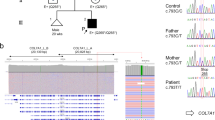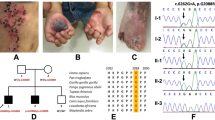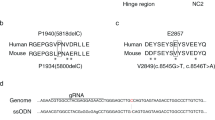Abstract
Recessive dystrophic epidermolysis bullosa is a severe mutilating genodermatosis. Previous ultrastructural demonstrations of altered anchoring fibrils, and recent genetic linkage analyses have suggested that type VII collagen, the major component of anchoring fibrils, is a candidate gene. We have identified a homozygous methionine–to–lysine mutation in two affected siblings, while their unaffected mother and half–brother are heterozygous carriers. The mutation resides in a highly conserved region of the C–terminus of type VII collagen, strongly suggesting that it is the cause of the disease in this family.
This is a preview of subscription content, access via your institution
Access options
Subscribe to this journal
Receive 12 print issues and online access
$209.00 per year
only $17.42 per issue
Buy this article
- Purchase on Springer Link
- Instant access to full article PDF
Prices may be subject to local taxes which are calculated during checkout
Similar content being viewed by others
References
Fine, J.D. et al. Revised clinical and laboratory criteria for subtypes of inherited epidermolysis bullosa. A consensus report by the subcommittee on diagnosis and classification of the national epidermolysis bullosa registry. J. Am. Acad. Dermatol. 24, 119–135 (1991).
Lin, A.N. & Carter, D.M. (eds) Epidermolysis bullosa. Basic and clinical aspects. (Springer, New York, 1992).
Uitto, J. & Christiano, A.M. Molecular genetics of the cutaneous basement membrane zone. Perspectives on epidermolysis bullosa and other blistering skin diseases. J. clin. Invest. 90, 687–692 (1992).
Fuchs, E. & Coulombe, P.A. Of mice and men: genetic skin diseases of keratin. Cell 69, 899–902 (1992).
Epstein, E.H., Jr. Molecular genetics of epidermolysis bullosa. Science 256, 799–804 (1992).
Bonifas, J.M., Rothman, A.L. & Epstein, E.H., Jr. Epidermolysis bullosa simplex: evidence in two families for keratin gene abnormalities. Science 254, 1202–1205 (1991).
Coulombe, P.A. et al. Point mutations in human keratin 14 genes of epidermolysis bullosa simplex patients: genetic and funtional analyses. Cell 66, 1301–1311 (1991).
Lane, E.B. et al. A mutation in the conserved helix termination peptide of keratin 5 in hereditary skin blistering. Nature 356, 244–246 (1992).
Rothnagel, J.A. et al. Mutations in the rod domains of keratins 1 and 10 in epidermolytic hyperkeratosis. Science 257, 1128–1130 (1992).
Cheng, J. et al. The genetic basis of epidermolytic hyperkeratosis: a disorder of differentiation-specific epidermal keratin gene. Cell 70, 811–819 (1992).
Chipev, C.C. et al. A leucine → proline mutation in the H1 subdomain of keratin 1 causes epidermolytic hyperkeratosis. Cell 70, 821–828 (1992).
Coulombe, P.A., Hutton, M.E., Vassar, R. & Fuchs, E. A function of keratins and a common thread among different types of epidermolysis bullosa simplex diseases. J. cell Biol. 115, 1661–1674 (1991).
Fuchs, E., Esteves, R.A. & Coulombe, P.A. Transgenic mice expressing a mutant keratin 10 gene reveal the likely genetic basis for epidermolytic hyperkeratosis. Proc. natn. Acad. Sci. U.S.A. 89, 6906–6910 (1992).
Tidman, M.J. & Eady, R.A.J. Evaluation of anchoring fibrils and other components of the dermal-epidermal junction in dystrophic epidermolysis bullosa by a quantitative ultrastructural technique. J. invest. Dermatol. 84, 374–377 (1985).
Bruckner-Tuderman, L. Collagens of the dermo-epidermal junction: role in bullous disorders. Eur. J. Dermatol. 1, 89–100 (1991).
Burgeson, R.E. et al. The structure and function of type VII collagen. Ann. N.Y. Acad. Sci. 580, 32–43 (1990).
Uitto, J., Chung-Honet, L.C. & Christiano, A.M. Molecular biology and pathology of type VII collagen. Exp. Dermatol. 1, 2–11 (1992).
Ryynänen, M. et al. Human type VII collagen: genetic linkage of the gene (COL7A1) on chromosome 3 to dominant dystrophic epidermolysis bullosa. Am. J. hum. Genet. 49, 797–803 (1991).
Ryynänen, M. et al. Genetic linkage of type VII collagen (COL7A1) to dominant dystrophic epidermolysis bullosa in families with abnormal anchoring fibrils. J. clin. Invest. 89, 974–980 (1992).
Gruis, N.A. et al. Genetic linkage between the collagen VII (COL7A1) gene and the autosomal dominant form of dystrophic epidermolysis bullosa in two Dutch kindreds. J. invest. Dermatol. 99, 528–530 (1992).
Al-Imara, L. et al. Linkage of autosomal dominant dystophic epidermolysis bullosa in three British families to the marker D3S2 close to the COL7A1 locus. J. med. Genet. 29, 381–382 (1992).
Hovnanian, A. et al. Genetic linkage of recessive dystrophic epidermolysis bullosa to the type VII collagen gene. J. clin. Invest. 90, 1038–1046 (1992).
Parente, M.G. et al. Human type VII collagen: cDNA cloning and chromosomal mapping of the gene. Proc. natn. Acad. Sci. U.S.A. 88, 6931–6935 (1991).
Greenspan, D.S., Byers, M.G., Eddy, R.L., Hoffman, G.G. & Shows, T.B. Localization of the human collagen gene COL7A1 to 3p21.3 by fluorescence in situ hybridization. Cytogenet. Cell Genet. 62, 35–36 (1993).
Christiano, A.M. et al. The large non-collagenous domain (NC-1) of type VII collagen is amino-terminal and chimeric. Homology to cartilage matrix protein, the type III domains of fibronectin and the A domains of von Willebrand factor. Human molec. Genet. 1, 475–481 (1992).
Ryynänen, J., et al. Type VII collagen gene expression by cultured human cells and in fetal skin. Abundant mRNA and protein levels in epidermal keratinocytes. J. clin. Invest. 89, 163–168 (1992).
Greenspan, D.S. et al. The carboxyl-terminal half of type VII collagen, including the non-collagenous NC-2 domain and intron/exon organization of the corresponding region of the COL7A1 gene. Human molec. Genet. 2, 273–278 (1993).
Li, K. et al. cDNA cloning and chromosomal mapping of the mouse type VII collagen gene (COL7A1). Genomics (in the press).
Christiano, A.M., Chung-Honet, L.C., Hovnanian, A. & Uitto, J. PCR-based detection of two exonic polymorphisms in the human type VII collagen gene (COL7A1) at 3p21.1. Genomics 14, 827–828 (1992).
Kuivaniemi, H., Tromp, G. & Prockop, D.J. Mutations in collagen genes: causes of rare and some common diseases in humans. FASEB J. 5, 2052–2060 (1991).
Prockop, D.J. Mutations in collagen genes as a cause of connective-tissue diseases. New Engl. J. Med. 326, 540–546 (1992).
Hovnanian, A. et al. A missennse mutation in the rod domain of keratin 14 associated with recessive epidermolysis bullosa simplex. Nature Genet. 3, 327–332 (1993).
Booth, B.A., Polak, K.L. & Uitto, J. Collagen biosynthesis by human skin fibroblasts. I. Optimization of the culture conditions for synthesis of type I and type III procollagens. Biochim. Biophys. Acta 607, 145–160 (1980).
Chomczynski, P. & Sacchi, N. Single-step method of RNA isolation by acid guanidium thiocyanate-phenol-chloroform extraction. Anal. Biochem. 162, 156–159 (1987).
Orita, M., Iwahana, H., Kanazawa, H., Hayashi, K. & Sekiya, T. Detection of polymorphisms of human DNA by gel electrophoresis as single-strand conformation polymorphisms. Proc. natn. Acad. Sci. U.S.A. 86, 2766–2770 (1989).
Author information
Authors and Affiliations
Rights and permissions
About this article
Cite this article
Christiano, A., Greenspan, D., Hoffman, G. et al. A missense mutation in type VII collagen in two affected siblings with recessive dystrophic epidermolysis bullosa. Nat Genet 4, 62–66 (1993). https://doi.org/10.1038/ng0593-62
Received:
Accepted:
Issue Date:
DOI: https://doi.org/10.1038/ng0593-62
This article is cited by
-
Epidermal cell junctions and their regulation by p63 in health and disease
Cell and Tissue Research (2015)
-
Molecular Heterogeneity of Blistering Disorders: The Paradigm of Epidermolysis Bullosa
Journal of Investigative Dermatology (2012)
-
Unveiling the Roots of Monogenic Genodermatoses: Genotrichoses as a Paradigm
Journal of Investigative Dermatology (2012)
-
Correction of Dog Dystrophic Epidermolysis Bullosa by Transplantation of Genetically Modified Epidermal Autografts
Journal of Investigative Dermatology (2011)



